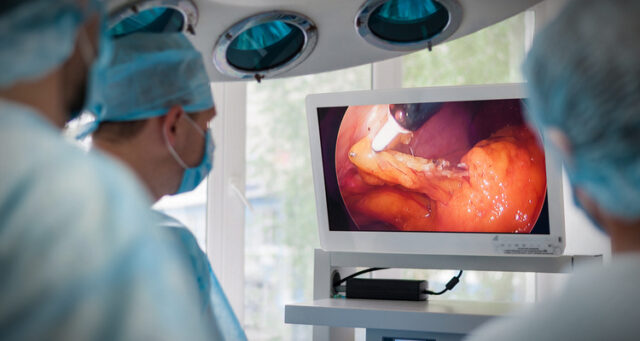
BiBBInstruments at forefront of cancer diagnostics revolution
Fine needle instruments are being replaced by core needle biopsy instruments capable of delivering cleaner tissue samples for more accurate analysis, thus providing more reliable diagnostics. Swedish medtech BiBBInstruments is following the trend by developing the world’s first CE-marked endoscopic ultrasound-guided core needle biopsy device – EndoDrill. As the cancer burden increases, and as new precision medicine technologies that rely heavily on high quality tissue sampling hit the market, BiBB’s innovation could not come at a better time.
Despite the advancements made in cancer therapeutics over the last decade, cancer remains one of the top causes of death worldwide. The disease is often caught too late, in its most aggressive stages. Therefore, early detection and diagnosis have an essential role to play in keeping the cancer death rates low.
Shift towards core needle biopsies
Up until the early 2000s, biopsy instruments meant for cancer detection in peripheral organs of the body, e.g., breast, relied mainly on fine needle aspiration (FNA) to collect tissue samples. This cytology method provides blood-contaminated cell samples – suboptimal for accurate analysis and subsequent diagnosis.
Since then, we have seen a shift towards core needle biopsies (CNB) – histological tissue sampling with slightly larger biopsy needle instruments. This type of sampling delivers intact tissue suitable not only for cytology analysis but also for histology analysis, which yields more detailed and accurate data.
Core needle biopsy still lacking in EUS
For deeper less accessible organs, e.g., stomach, pancreas, lung and bladder, the shift to CNB is still in the starting blocks. Sampling here requires a more advanced endoscopic procedure that involves the use of a long flexible tube able to reach the deepest cavities of the body.
Modern endoscopy for the gastrointestinal (G.I.) regions is done in tandem with ultrasound for better depth visualisation and tissue targeting. This method of examination, endoscopic ultrasound (EUS), is minimally invasive, and it is the fastest growing segment in the endoscopy arena. While EUS technology has revolutionised the ability to diagnose cancers of the G.I. tract, it still relies on FNA and recently developed fine needle biopsy (FNB) for tissue sampling, which comes with the aforementioned drawbacks leading to high failed detection rates.
Pioneering EUS-CNB – BiBB is ready for the future
The Lund-based medtech BiBBInstruments ”BiBB” has developed an alternative sampling method based on CNB. In fact, the company’s biopsy instrument EndoDrill, is the world’s first CE-marked (2020) EUS biopsy device that enables sampling of core tissue. Hence, the company’s vision is to be the first to offer EUS-CNB.
Read a more in-depth overview of the company, which includes a link to a video showing how EndoDrill works, here.
BiBB’s EndoDrill puts the company in a favourable market position, especially considering what the future holds for cancer diagnostics. It is estimated that over the next 20 years, the cancer burden will almost double mainly due to an aging population. Moreover, cancer screening programmes are relying more and more on liquid biopsies, which require confirmation through endoscopic tissue sampling. Last but not least, precision medicine techniques will continue to advance, and those will also heavily rely on high-quality tissue sampling – something that BiBB’s instrument has so far shown itself able to provide.
Read more about the market potential for BiBB here.
Clinical data gives BiBB momentum
So far, BiBB has achieved proof-of-concept (PoC) in difficult-to-diagnose tumours of the upper G.I. tract (SEL). The company announced in late 2021 that its clinical evaluation study EDMX01 had been completed earlier than expected, as data pointed to a high level of effectiveness and safety after a series of successful samplings with EndoDrill. Read more here. These positive results increase the likelihood that EndoDrill will also work for sampling in the most severe cancers, like lung and pancreatic cancer.
BiBB’s second clinical study, EDUX02, is a pilot study in patients with suspected muscle invasive bladder cancer (MIBC). For this type of cancer, because of the organ’s location, conventional examination relies only on a visual endoscopy without tissue sampling, thus giving a limited early understanding of a potential tumour. Therefore, patients with suspected MIBC are often forced to undergo an invasive surgical procedure called TURBT (Transurethral Resection for Bladder Tumour) for biopsy sampling and treatment.
EDUX02 is expected to be completed during this quarter. If positive, a larger randomised efficacy study that will include 64 patients will follow. This study has already been approved by regulatory authorities. Read more about the study and its potential impact here.
The EndoDrill promise
All in all, BiBB brings forward a strong case for investors. With EndoDrill, the company is innovating in the fastest growing endoscopy segment, EUS, and is doing so by developing the world’s first CE-marked EUS-CNB instrument. Moreover, BiBB’s device has so far performed very well in clinical evaluation, achieving PoC in deeply situated tumours in the stomach.
Finally, BiBB has the opportunity be the first in the world to offer high-quality biopsies at the initial endoscopic examination in MIBC patients. BioStock will continue to follow BiBB as we await results from their bladder cancer pilot study, and with other potentially value-adding milestones expected to come this year.


